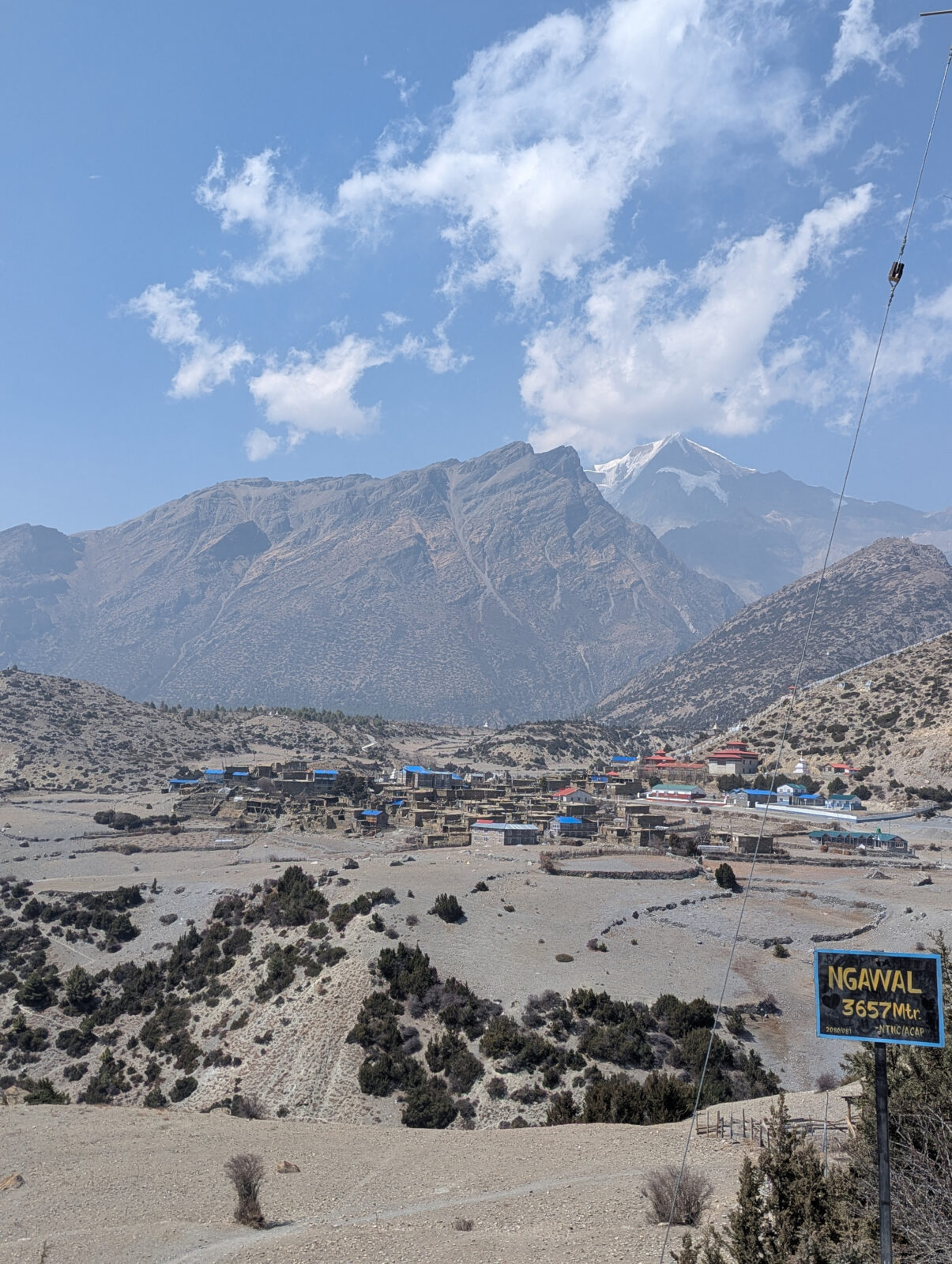
The village of Ngawal with the signpost. Photo by Niranjan Kunwar

The village of Ngawal with the signpost. Photo by Niranjan Kunwar
One thing I’ve learned in the last five years is the ability to cultivate more stillness. Breathwork was necessary during lockdown, but even after the world opened, I continued the daily ritual, noting how rivulets of old thoughts were changing courses, stains of unprocessed emotions drying up. Without societal influence, my internal ecosystem grew organically. Instead of spending time with people IRL, I gravitated toward fictional characters, took my pet for neighborhood walks, even began to garden. Arid patches of my brain are now dotted with succulent ideas; swampy corners inside my heart are filled with evergreens. Sometimes, flowers bloom.
This perhaps explains why I was drawn to the idea of spending two weeks in the remote Manang Valley—which lies north of the Annapurna massif and south of Tibet—for an artist residency program in the spring of 2025. It was at an exhibition opening for the first cohort of resident artists, in the late autumn of 2024 in Kathmandu, that I first expressed my interest to the founders Amar Gurung, whose parents were born in Manang, and Jo Rankine, an Australian artist.
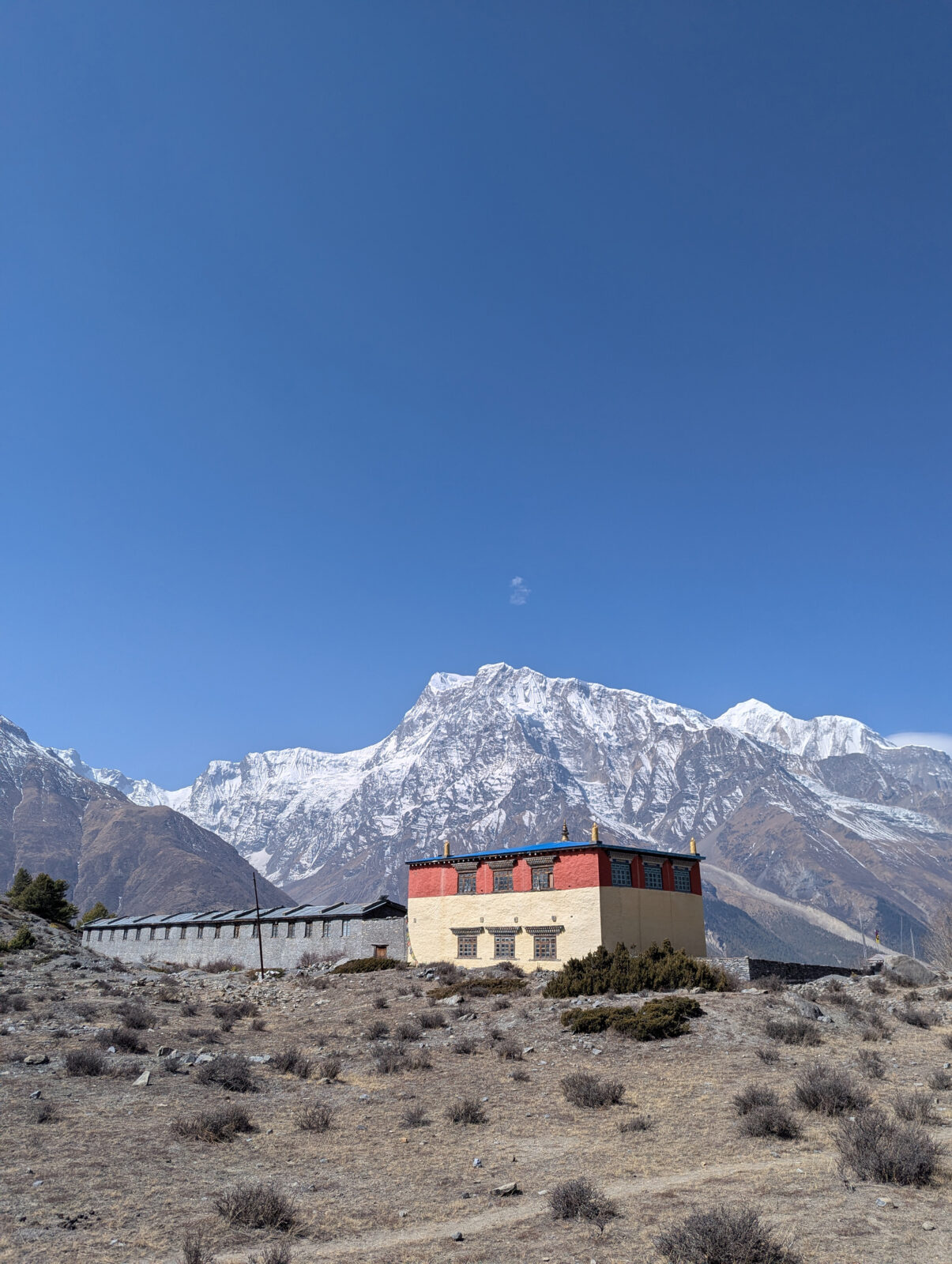
A monastery at the edge of Ngawal village. Photo by Niranjan Kunwar
The Manang Artist Residency is located in the historic village of Ngawal at an altitude of 3,675 meters. Although I have been on several high-altitude treks in Nepal with groups of friends, those missions were usually charged by adrenaline and came with a fixed goal and deadline. I had never learned to relax above 3,000 meters and acquaint myself with the rhythms of local life in the mountains. As the residency approached, I was also slightly nervous about living in close proximity with strangers, having embraced solitude and silence in the recent past.
In any case, it seemed like a worthy step for a single, queer guy in early middle-age. And so, two days after the spring equinox, a dozen of us left Kathmandu early one morning and drove west of Manaslu, driving around the Annapurnas and climbing up to the village of Ngawal. The journey took two full days, with an overnight en route. The lodge where we stayed offered a stunning view of the famous mountain range. But what caught my attention the following morning was a horizontal hill that spread right in front of the mountains.
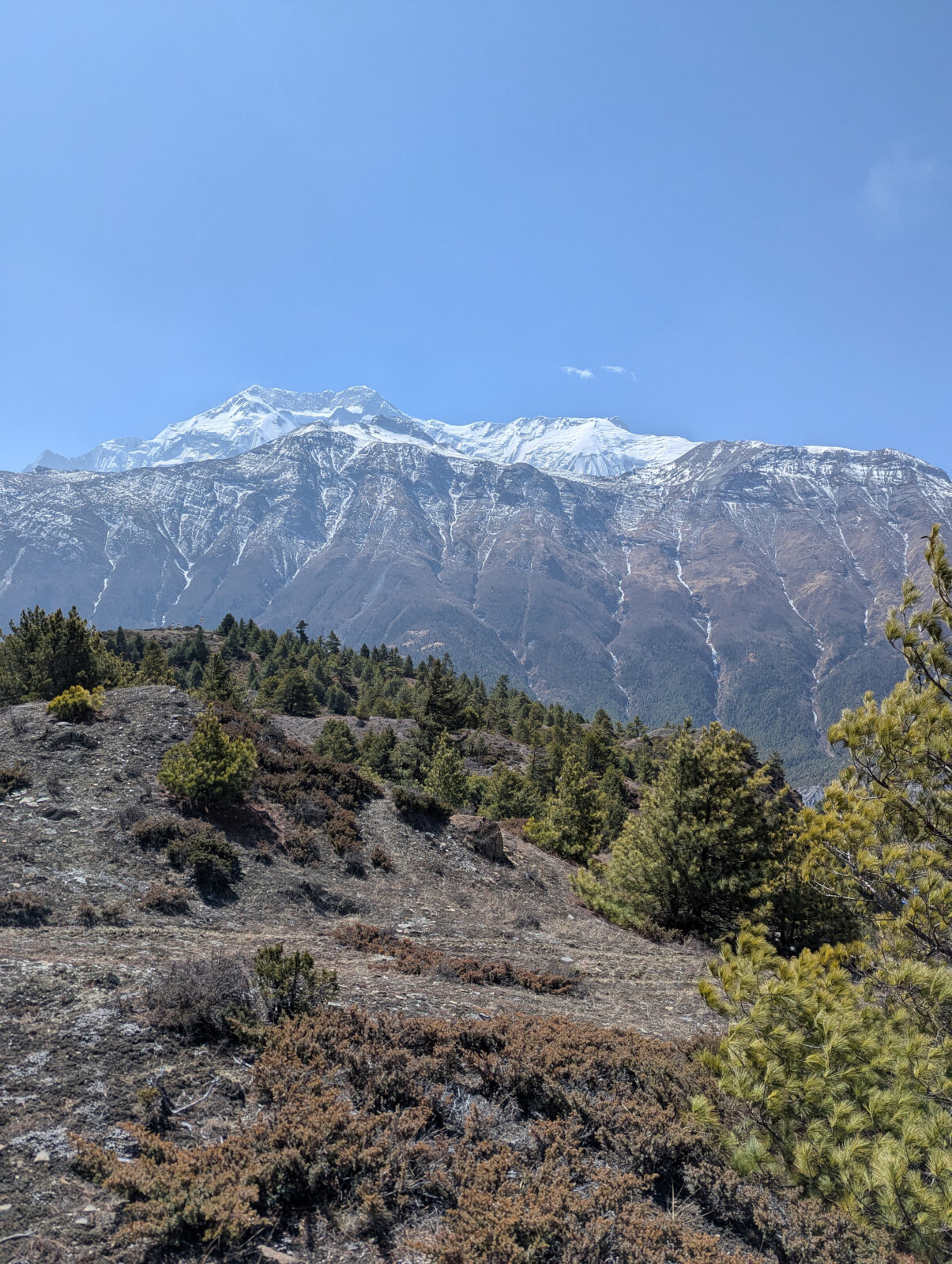
The horizontal hill in front of Annapurna II and Annapurna IV. Photo by Niranjan Kunwar
Distinct trails of monsoon rills ran from its snow-flecked ridge to the valley below, segmenting the body. At the end of March, ice partly filled the rills, but the bottom of the hill was a rich green due to the coniferous forest. The midsection—where the forest thinned out and gave way to dry alpine shrubs and grass—shimmered golden on sunny days. Annapurna III glittered to the right of this hill, threatening to overwhelm one’s senses, and a couple of other peaks, including that of Tilicho, were also visible. So why was this horizontal hill, which might appear mundane compared to the surrounding mountains, capturing my attention?
So why was this horizontal hill, which might appear mundane compared to the surrounding mountains, capturing my attention?
The residency program was open-ended, designed to allow residents to craft their own plans and projects. A series of synchronicities had led me to think I’d write a piece on Milarepa during my time there.
Shortly before departure, I finished reading Thomas Bell’s recent book, Human Nature: A Walking Tour of the Himalayan Landscape. In a section on Tibetan folklore, he recounts the life story of the 11th-century siddha Milarepa. Coincidentally, that same week, Mukesh Shrestha’s painting Milarepa: A Story of Struggle, Anguish, Resolution, and Triumph was unveiled at Taragaon Next in Kathmandu. Anticipating my Manang visit and sensing an emerging connection, I smiled as I read the curatorial note: “This exhibition invites viewers to reflect on their own paths, echoing the timeless lesson that even the greatest suffering can lead to profound enlightenment.”
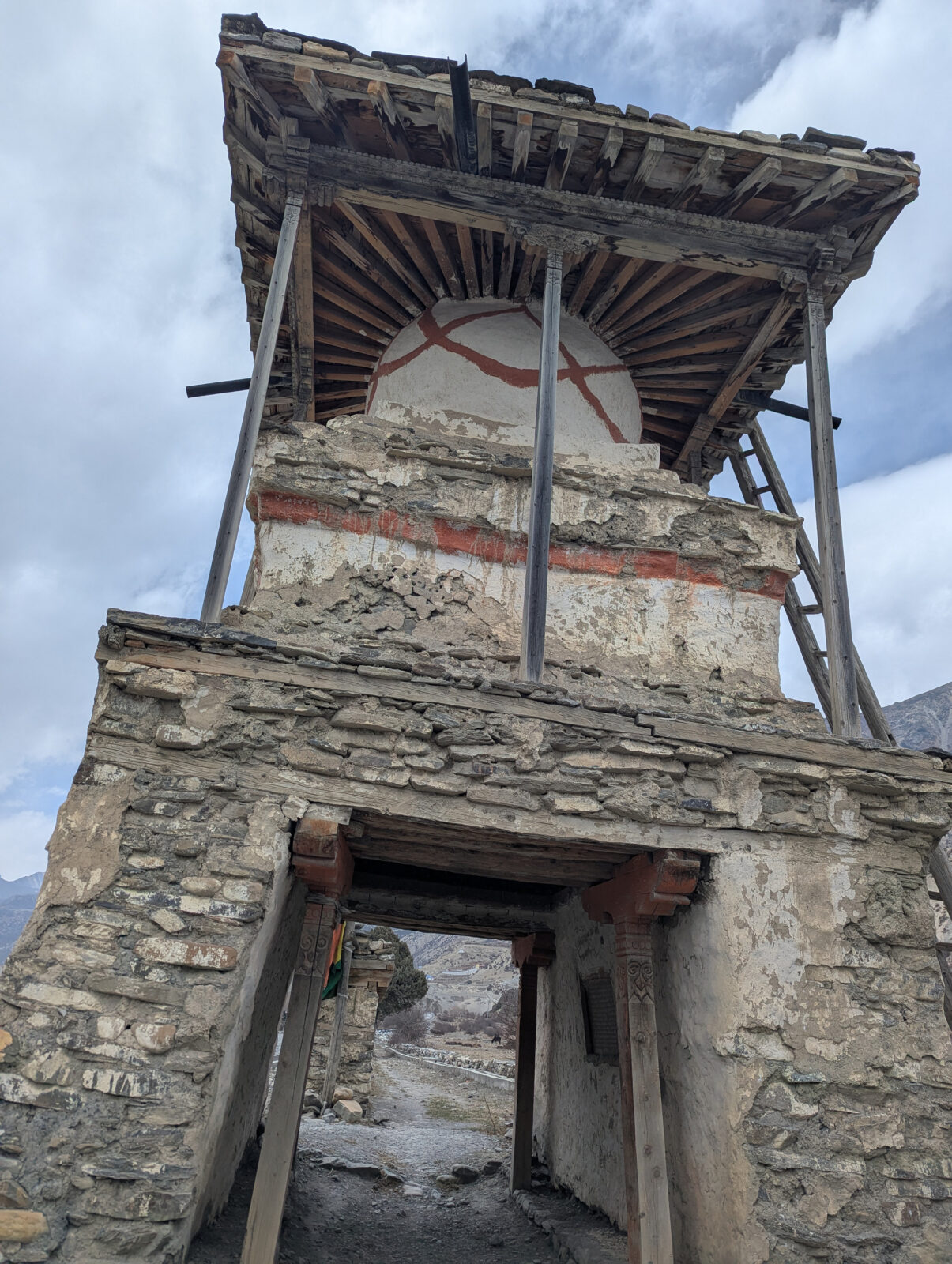
One of several ancient gates of Manang. Photo by Niranjan Kunwar
Then a friend told me about Milarepa’s Cave in Manang, a spot where he is believed to have spent time meditating. It turned out to be a mere day trip from our lodge. Once there, I hired a local biker, Karma, to take me to the cave. Devotees had recently constructed a small monastery at the location, but I was more impressed by the glacial moraine visible from the edge of the Milarepa cliff.
Karma amused me with local intel. On the return trip, he pointed at the midsection of my horizontal hill. “You see that section without trees? That’s where we go to find the bug.” He was referring to Yarsagumba, Himalayan cordyceps or caterpillar fungus, which fetches a large sum in the Chinese black market. “Why is the demand so high?” I asked. “If you crush the dead, dry bug and consume a pinch of its powder daily, it gives you great life force,” he explained.
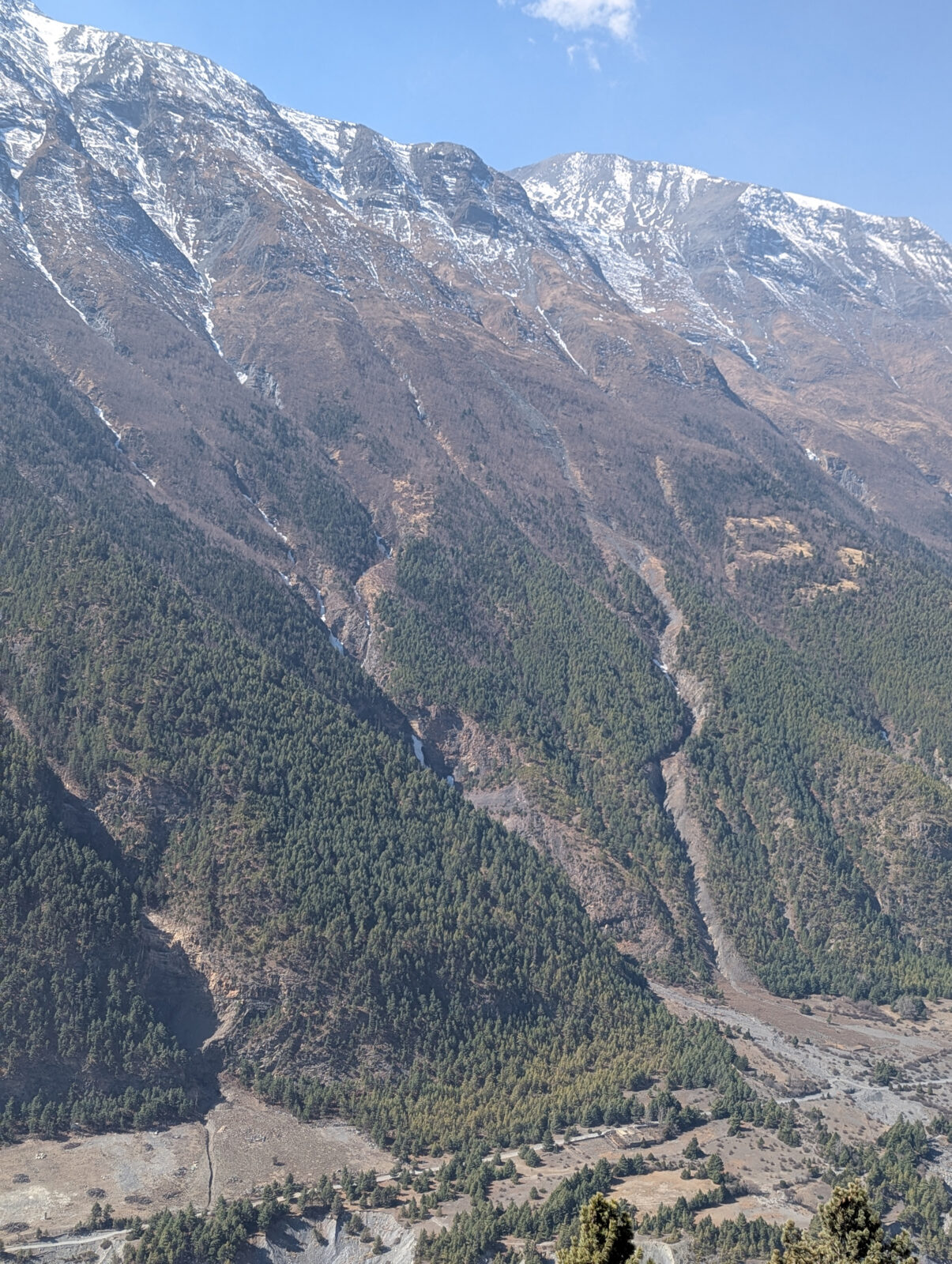
The hill’s coniferous bottom—folds of a dog’s furry coat. Photo by Niranjan Kunwar
I didn’t end up writing a piece on Milarepa. Instead, I spent several mornings exploring the village’s brown, barren edges dotted with black juniper shrubs and green-golden pine, amazed by the Annapurnas, intrigued by the horizontal hill. I was high, staring higher, the mountain breeze fresh and fierce. As I gazed down at Manang Valley and the turquoise strip of the Marshyangdi River, I realized how clear my mind was, how still my emotions. It seemed like my gentle horizontal hill was helping me calm down and settle in.
Even while walking down to the valley at the end of the week, I kept looking at the hill, finally seeing its face for the first time. From Ngawal, she looked like a fluffy striped dog crouching on the ground. From the valley floor, her patchy face and segmented body made her look more like a giant arthropod from a Miyazaki film. In any case, she seemed like a sacred, friendly being, nestling her face close to the houses of Humde.
It seemed like my gentle horizontal hill was helping me calm down and settle in.
That same week, I received a Substack newsletter from Dr. Sharon Blackie, urging her readers to curate their inner imaginarium. To explain the concept, Dr. Blackie referenced the philosopher Henry Corbin, who used the term mundus imaginalis, the “imagined world,” to describe a particular order of reality referred to in ancient Sufi texts. She wrote, “These texts tell us that, between the physical world of our senses and the world of abstract intellect or ‘mind’ which we imagine sits inside our heads, lies another world: the world of the image—and it’s a world that is just as real as either of the others.”
“The imaginal world is the world of psyche—of soul,” Blackie elaborated, and it’s vital to pay attention to it because “it’s the source of synchronicities, of creative insights; it penetrates into our dreams and visionary experiences.” James Hillman developed his idea of “image and the imagination”—what he called the “poetic basis of mind”—as the foundation for his depth psychology. Carl Jung, too, worked deeply with images and archetypes to develop his theory of the collective unconscious.
Most of us have had the experience of noticing clouds shaped like animals, birds, or other creatures.
Most of us have had the experience of noticing clouds shaped like animals, birds, or other creatures. Rather than dismiss such thoughts as frivolous, these psychologists urge us to engage actively and thoughtfully with these images and associations that spring up spontaneously from our imagination.
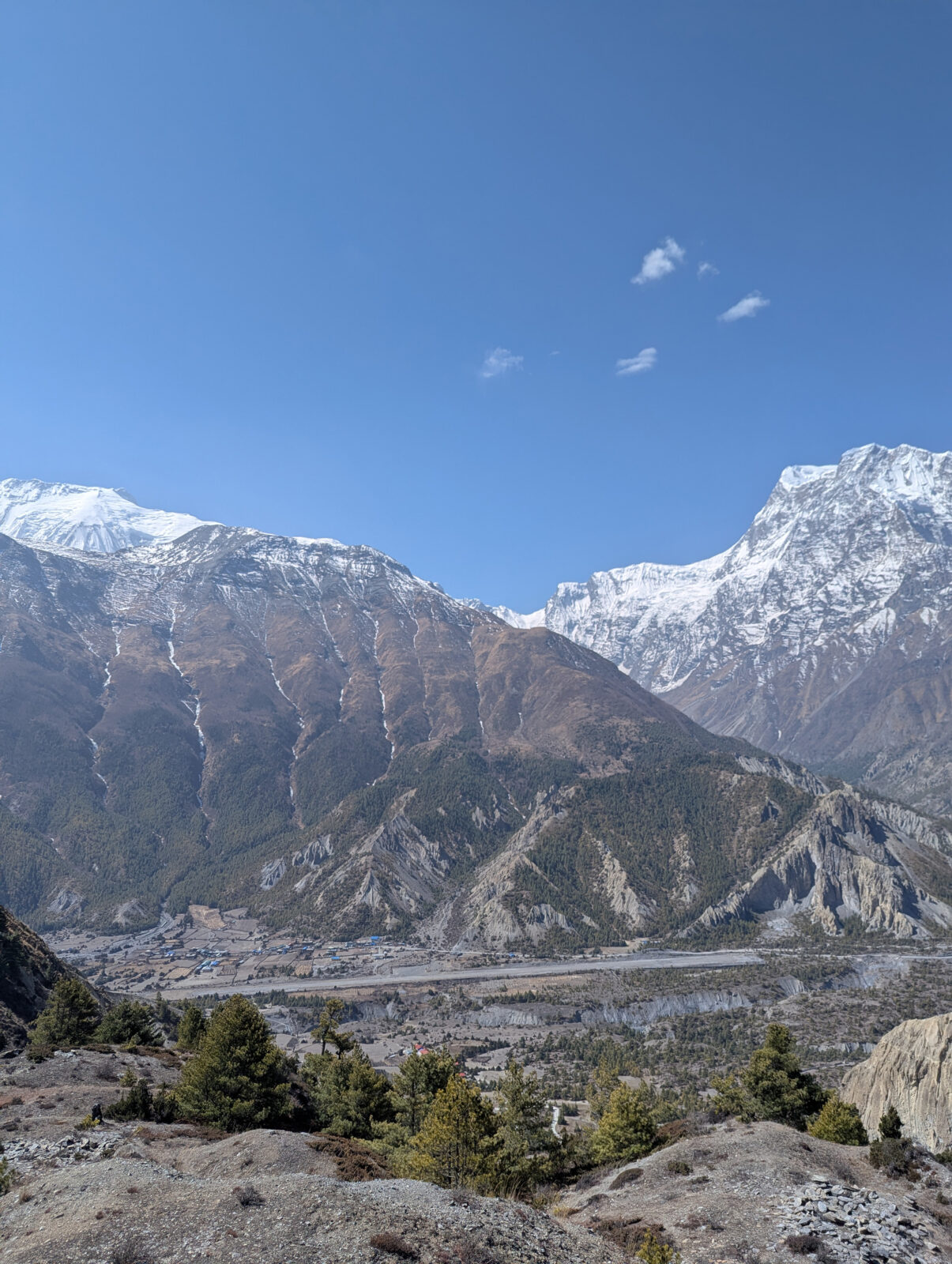
The hill’s patchy face—triple-headed?—as seen from the valley floor. Annapurna III stands next to it. Photo by Niranjan Kunwar
And so, I gazed at the hill, imagining all kinds of things. If the Annapurnas are celebrities in the limelight, the horizontal hill is that lady sitting quietly on a sofa. You feel comforted by her warm eyes and soft smile. But her form is not human. Nor does she resemble an Eastern goddess or a Western superhero. She is a friend from another world, just like the residents here in Manang. When we gathered in the common room, exchanging anecdotes around a black woodburning stove, I finally understood why my intuition guided me to join this trip. Solitude is necessary—but so is company and community. I needed that reminder.
James Hillman wrote that when we engage with images from art or open up our imagination to the natural world, our psyche begins to speak to us, “thereby recovering the world as a place of soul.” “And this is why imaginal work matters,” writes Dr. Blackie, “because it builds soul.”
I returned to Kathmandu reassured, as if the daily breathwork and the regular cultivation of stillness had helped me commune with Ngawal’s sacred being, this rocky entity, a water-bearer, clothed and dignified in her alpine ensemble.
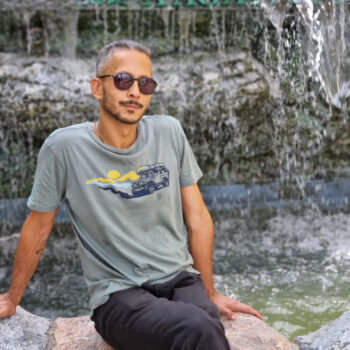
Niranjan Kunwar is an educationist whose career includes teaching in primary schools and mentoring teachers in Nepal. His memoir, Between Queens and the Cities, was published by FinePrint in 2020. The chapter book Mijok’s Trip and his English translation of Seto Dharti are forthcoming. Kunwar has an MSEd from the City University of New York and a diploma in narrative practices and ideas.
Get the latest news and stories from the Rubin, plus occasional information on how to support our work.